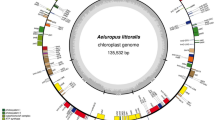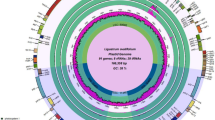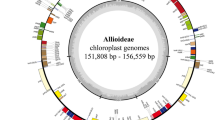Abstract
THE relationship of green algae to land plants has greatly interested botanists for more than a century. In recent years, several characters, particularly ultrastructural ones, have been used to define a green algal group (Charophyceae) from which land plants are thought to have arisen (refs 1–3, but see ref. 4). Here we provide the first molecular genetic evidence in support of the charophycean origin of land plants. Group II introns have previously been found in both the tRNAAla and tRNAIle genes of all land plant chloroplast DNAs examined, whereas all algae and eubacteria examined have uninterrupted genes5–19. The distribution of these introns in Coleochaete, Nitella and Spirogyra, members of the Charophyceae, confirms that these taxa are part of the lineage that gave rise to land plants. Furthermore, the intron data place Coleochaete and Nitella closer to land plants than Spirogyra. These introns were most probably acquired by the chloroplast genome more than 400–500 million years ago, the time of land plant origin20.
This is a preview of subscription content, access via your institution
Access options
Subscribe to this journal
Receive 51 print issues and online access
$199.00 per year
only $3.90 per issue
Buy this article
- Purchase on Springer Link
- Instant access to full article PDF
Prices may be subject to local taxes which are calculated during checkout
Similar content being viewed by others
References
Mattox, K. R. & Stewart, K. D. Systematics of the Green Algae (Academic, London and Ontario, 1984).
Bremer, K. Cladistics 1, 369–385 (1985).
Mishler, B. D. & Churchill, S. P. Cladistics 1, 305–328 (1985).
Stebbins, G. L. & Hill, G. J. C. Am. Nat. 115, 342–353 (1980).
Sprinzl, M., Hartmann, T., Weber, J., Blank, J. & Zeidler, R. Nucleic Acid Res. Seq. Suppl. 17, r1–r172.
Tomioka, N. & Sugiura, M. Molec. gen. Genet. 193, 427–430 (1984).
Markowicz, Y., Mache, R. & Loiseaux-De Göer, S. Pl. molec. Biol. 10, 465–469 (1988).
Delaney, T. P. & Cattolico, R. A. Curr. Genet 16, 221–229 (1989).
Graf, L., Hossel, H. & Stutz, E. Nature 286, 908–910 (1980).
Janssen, I., Mucke, H., Löffelhardt, W. & Bohnert, H. J. Pl. molec. Biol. 9, 479–484 (1987).
Schneider, M. & Rochaix, J. D. Pl. molec. Biol. 6, 265–270 (1986).
Yamada, T. & Shimaji, M. Nucleic Acids Res. 14, 3827–3839 (1986).
Yamada, T. & Shimaji, M. Molec. gen. Genet. 208, 377–383 (1987).
Ohyama, K. et al. Nature 322, 572–574 (1986).
Shinozaki, K. et al. EMBO J. 5, 2043–2049 (1986).
Stumann, B. M., Lehmbeck, J., Bookjans, G. & Henningsen, K. W. Phys. plant. 72, 139–146 (1988).
de Lanversin, G. & Pillay, D. T. N. Theor. appl. Genet. 76, 443–448 (1988).
Massenet, O., Martinez, P., Seyer, P. & Briat, J. Pl. molec. Biol. 10, 53–63 (1987).
Koch, W., Edwards, K. & Kossel, H. Cell 25, 203–213 (1981).
Taylor, T. N. Taxon 37, 805–833 (1988).
Shih, M-C., Heinrich, P. & Goodman, H. M. Science 242, 1164–1166 (1988).
Quigley, F., Martin, W. F. & Cerff, R. Proc. natn. Acad. Sci. U.S.A. 85, 2672–2676 (1988).
Dibb, N. J. & Newman, A. J. EMBO J. 8, 2015–2021 (1989).
Rogers, J. H. Trends Genet. 5, 213–216 (1989).
Cavalier-Smith, T. Nature 315, 283–284 (1985).
Turner, S., Burger-Wiersma, T., Giovannoni, S. J., Mur, L. R. & Pace, N. Nature 337, 380–382 (1989).
Woese, C. R. Microbiol. Rev. 51, 221–271 (1987).
Doolittle, W. F. Nature 272, 581–582 (1978).
Jansen, R. K. & Palmer, J. D. Proc. natn. Acad. Sci. U.S.A. 84, 5818–5822 (1987).
Palmer, J. D., Jansen, R. K., Michaels, H. J., Chase, M. W. & Manhart, J. R. Ann. Mo. Bot. Gard. 75, 1180–1206 (1988).
Devereux, C., Haeberli, P. & Smithies, O. Nucleic Acids Res. 12, 387–395 (1984).
Iwabe, N., Kuma, K., Hasegawa, M., Osawa, S. & Miyata, T. Proc. natn. Acad. Sci. U.S.A. 86, 9355–9359 (1989).
Author information
Authors and Affiliations
Rights and permissions
About this article
Cite this article
Manhart, J., Palmer, J. The gain of two chloroplast tRNA introns marks the green algal ancestors of land plants. Nature 345, 268–270 (1990). https://doi.org/10.1038/345268a0
Received:
Accepted:
Issue Date:
DOI: https://doi.org/10.1038/345268a0
This article is cited by
-
tRNA functional signatures classify plastids as late-branching cyanobacteria
BMC Evolutionary Biology (2019)
-
The Complete Mitochondrial Genome Sequence of the Hornwort Megaceros aenigmaticus Shows a Mixed Mode of Conservative Yet Dynamic Evolution in Early Land Plant Mitochondrial Genomes
Journal of Molecular Evolution (2009)
-
The origin and early evolution of plants on land
Nature (1997)
-
Use of a deviant mitochondrial genetic code in yellow-green algae as a landmark for segregating members within the phylum
Journal of Molecular Evolution (1997)
-
Green algae to land plants: An evolutionary transition
Journal of Plant Research (1996)
Comments
By submitting a comment you agree to abide by our Terms and Community Guidelines. If you find something abusive or that does not comply with our terms or guidelines please flag it as inappropriate.



